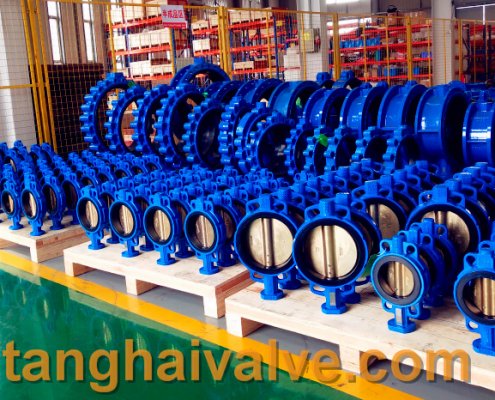Detailed introduction of soft sealing butterfly valve-(3)
Features of soft sealing butterfly valve:

ductile iron, DI, butterfly valve, manufacturer, center line, TH valve
1. Small and light, easy to disassemble and repair, and can be installed in any position.
2. The structure is simple and compact, the operating torque is small, and the 90-degree rotation opens quickly.
3. The flow characteristics tend to be straight, and the regulation performance is good.
4. The connection between the butterfly plate and the valve stem adopts a pinless structure, which overcomes possible internal leakage points.
5. The seal can be replaced, and the seal is reliable to achieve two-way sealing.
6. The butterfly plate can be sprayed with a coating layer, such as nylon or PTFE, according to user requirements.
7. The valve can be designed as flange connection and wafer connection.
8. The driving mode can be manual, electric or pneumatic.
Problems in the use of soft sealing butterfly valves:
1. Due to the principle of the triple eccentric structure, the sealing between the sealing surface of the valve plate and the valve seat is to press the valve plate against the valve seat by the torque of the transmission device. In the state of positive flow, the higher the medium pressure, the tighter the sealing extrusion. When the flow channel medium flows back, as the medium pressure increases, the unit positive pressure between the valve plate and the valve seat is less than the medium pressure, the seal begins to leak.
2. Due to structural conditions, this structure is not suitable for valves with a diameter below DN200, because the overall structure of the valve plate is too thick and the flow resistance is large.
3. Since the multilayer soft and hard stacked sealing ring is fixed on the valve plate, when the valve plate is normally open, the medium will wash its sealing surface positively, and the soft sealing tape in the metal sheet sandwich will directly affect the sealing performance after being washed.
high-performance soft sealing butterfly valve, characterized in that: the valve seat sealing ring is composed of multiple layers of stainless steel sheets on both sides of the soft T-shaped sealing ring.
The sealing surface of the valve plate and the valve seat is of an oblique cone structure, and the oblique cone surface of the valve plate is welded with temperature-resistant and corrosion-resistant alloy materials; the spring fixed between the adjusting ring pressure plate and the adjusting bolt of the pressure plate are assembled together. This structure effectively compensates for the tolerance zone between the shaft sleeve and the valve body and the elastic deformation of the valve stem under the medium pressure, and solves the sealing problem of the valve in the two-way interchangeable medium conveying process.
The sealing ring is composed of a soft T-shaped multi-layer stainless steel sheet on both sides, which has the dual advantages of metal hard and soft sealing. It has zero leakage sealing performance regardless of low temperature and high temperature. The test proves that in the positive flow state of the pool (the flow direction of the medium is the same as the rotation direction of the butterfly plate), the pressure of the sealing surface is produced by the torque of the transmission device and the action of the medium pressure on the valve plate. When the positive medium pressure increases, the tighter the oblique cone surface of the valve plate and the sealing surface of the valve seat are pressed, the better the sealing effect.
Therefore, unlike the prior art, the utility model does not install a soft and hard multilayer sealing ring on the valve plate, but directly installs it on the valve body. Adding an adjustment ring between the pressure plate and the valve seat is a very ideal two-way hard sealing method. . It can replace gate valves and ball valves.
In the reverse flow state, the seal between the valve plate and the valve seat is pressed against the valve seat by the torque of the driving device. With the increase of the reverse medium pressure, when the unit positive pressure between the valve plate and the valve seat is less than the medium pressure, the deformation energy stored by the spring of the adjusting ring after being loaded compensates for the tight pressure of the sealing surface of the valve plate and the valve seat Play the role of automatic compensation.



 © Copyright 2020 Tianjin Tanghaidongyang Valve Co., Ltd. All Rights Reserved.
© Copyright 2020 Tianjin Tanghaidongyang Valve Co., Ltd. All Rights Reserved.